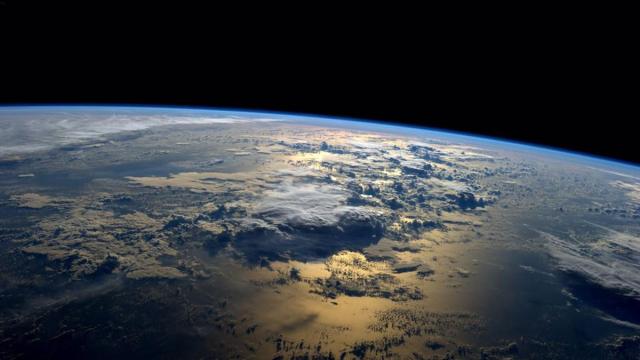Our planet is in a remarkably circular orbit around the Sun, but as new research points out, Earth’s orbit sometimes experiences a slight jolt, thanks to the combined gravitational influence of Jupiter and Venus. Incredibly, this cycle has been going on for at least 215 million years – and one scientist suggests it could possibly have influenced the trajectory of life on this planet, according to the new study published this week in Proceedings of the National Academy of Sciences.
Earth, as seen from the International Space Station. Photo: NASA/Reid Wiseman
Jupiter and Venus elongate Earth’s orbit to a tiny but measurable degree every 405,000 years, explained Dennis V. Kent, the lead author of the new study and a professor at Rutgers University-New Brunswick.
Kent believes this highly predictable and long-running celestial pattern could be used to study geological changes on Earth and subsequent environmental and ecological shifts – and because this cycle can be traced back to the Late Triassic Era, it could even tell us something about the dinosaurs.
Scientists thought something like this was happening, but empirical evidence was lacking, and models of planetary motion only went as far back as 50 million years ago.
To find traces of this hypothesised cycle on Earth, Kent’s team analysed sediment samples taken from the Chinle Formation in Arizona’s Petrified Forest National Park and the Newark basin, the site of a prehistoric lake. Core samples taken from these sites measured 8cm in diameter and about 520m long.
With each passing metre of depth, the researchers travelled back further and further into time, finally entering into the Triassic Period, the first of three geological epochs in which the dinosaurs lived.

Looking at the samples, the team chronicled the long-term record of reversals in the Earth’s magnetic poles. These periodic (but irregular) flips can be seen in sediments containing zircon – minerals with uranium that can be used for radiocarbon dating, allowing the sample to serve as a kind of clock. Climate shifts were seen in the sediment in the form of alternating wet and dry periods.
As noted in the study, the samples correlated with a remarkably continuous cycle, which Kent dubbed the astrochronostratigraphic polarity timescale (APTS), going all the way back some 215 million years to the Triassic Period.
“The climate cycles are directly related to how the Earth orbits the Sun and slight variations in sunlight reaching Earth lead to climate and ecological changes,” said Kent in a statement.
“The Earth’s orbit changes from close to perfectly circular to about five per cent elongated especially every 405,000 years,” he said. “Scientists can now link changes in the climate, environment, dinosaurs, mammals and fossils around the world to this… cycle in a very precise way.”
As noted in the study, Venus, the nearest planet to Earth, and Jupiter, the largest planet in the Solar System, seem to cause our orbital path to wobble due to their combined gravity, and they do so at these 405,000 year intervals.
As a result, suggests Kent, seasonal shifts on Earth may be more pronounced, producing hotter summers, colder winters, wetter rain seasons and drier droughts. When the cycle is at its peak, for example, more rain might fall in the tropics than during the weak point. Currently, our planet is in the middle of the cycle, with the last significant orbital influence happening about 200,000 years ago.
Indeed, armed with this potential empirical evidence for the APTS, scientists will be challenged to correlate these planetary interactions with known ecological shifts. For example, Kent said, the cycle could explain why dinosaurs had such a restricted geographical range during the Late Triassic, and why tropical dinosaurs didn’t spread further and dominate until the close of the Triassic Era.
This is all speculation, though. The new study provides evidence for the rhythmic climate cycle, but we still don’t know how or if it actually affected life on Earth.
“Looks like a sophisticated new attempt to provide a high-resolution timescale for the Late Triassic in North America; there’s been a lot of debate about it,” Paul Wignall, a paleo-environmentalist from the University of Leeds, told Gizmodo. “It’s misleading to claim that these orbital cycles have ‘influenced life forms’ though, because no evidence – or reason – is provided for this claim.”
Clearly much more research needs to be done, but it’s fascinating to think about how cosmic movements might affect Earth’s climate in a tangible way.
